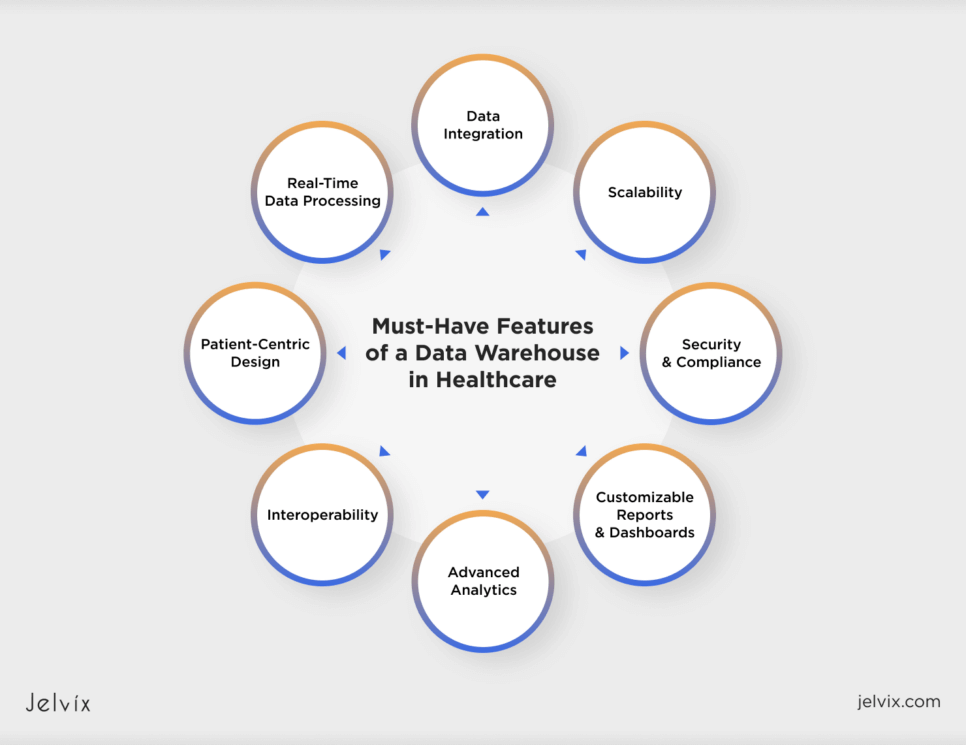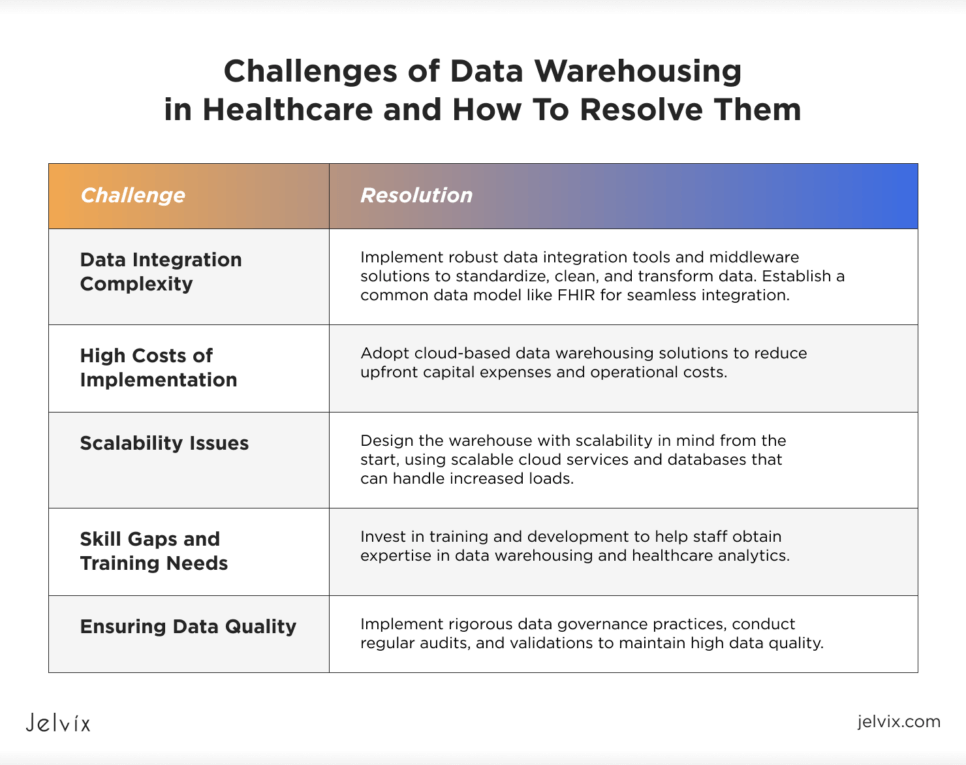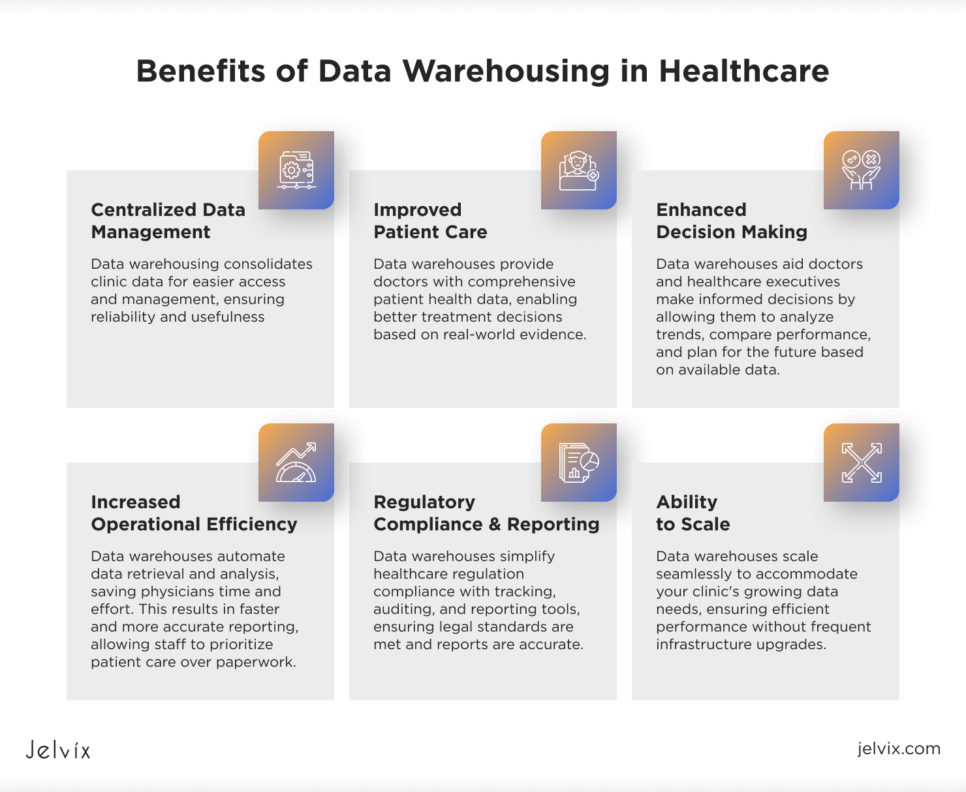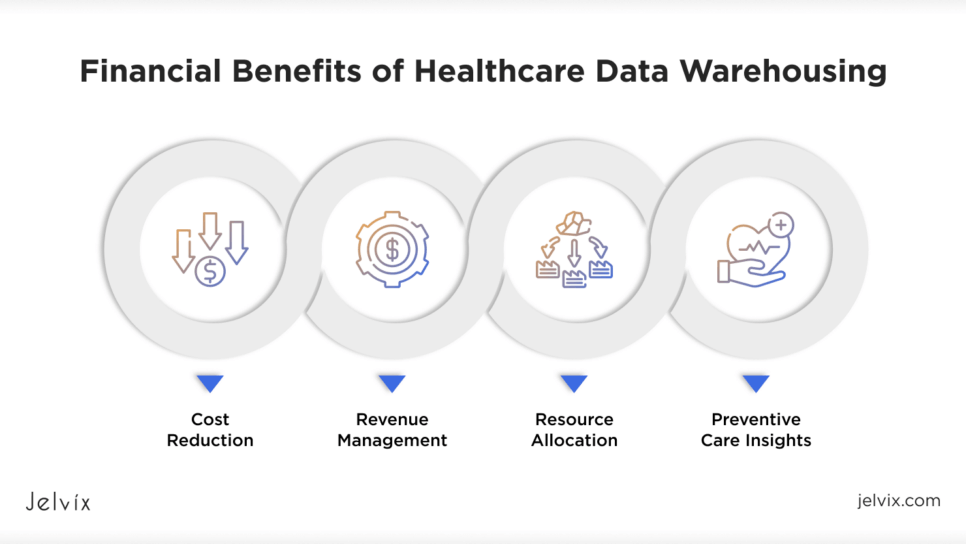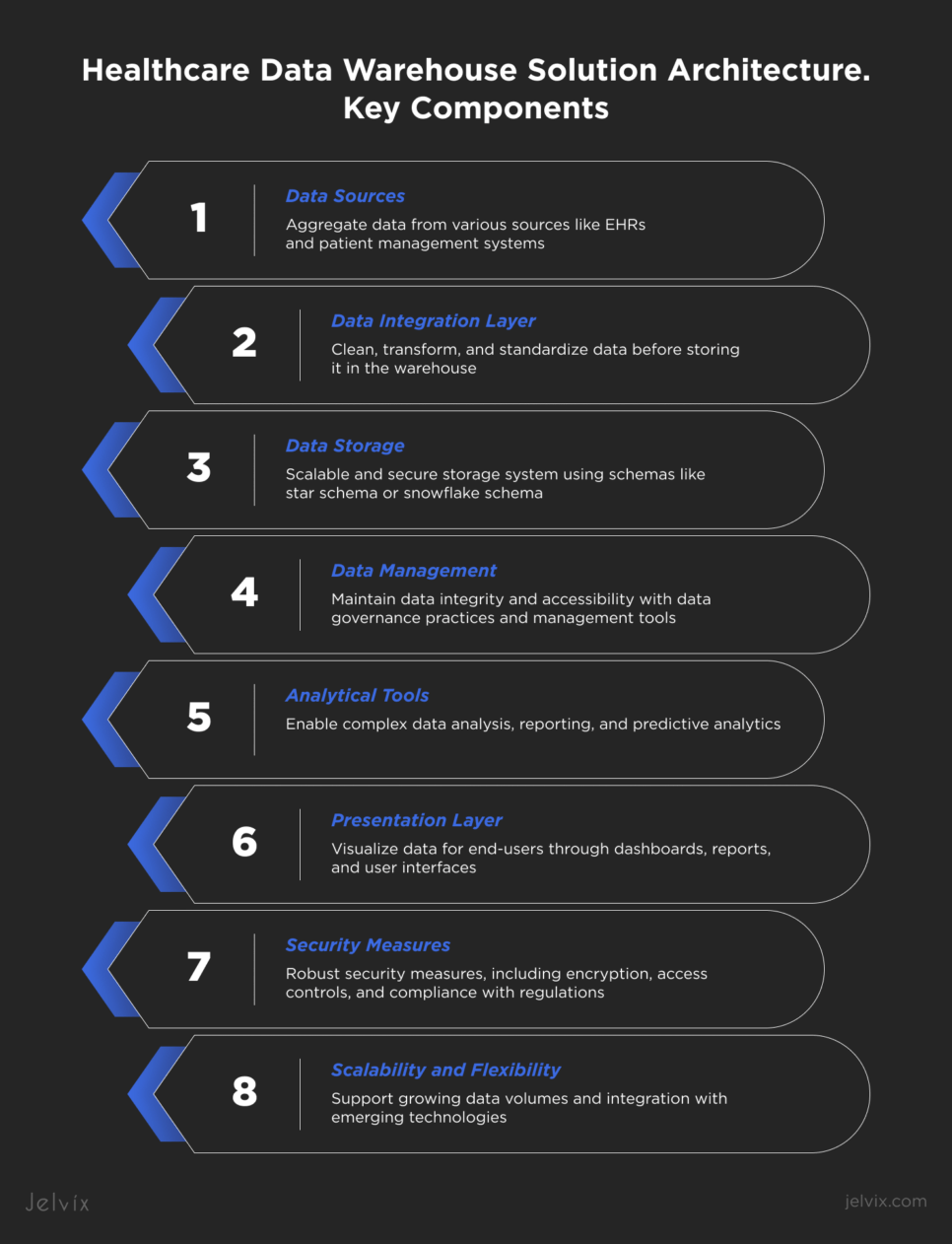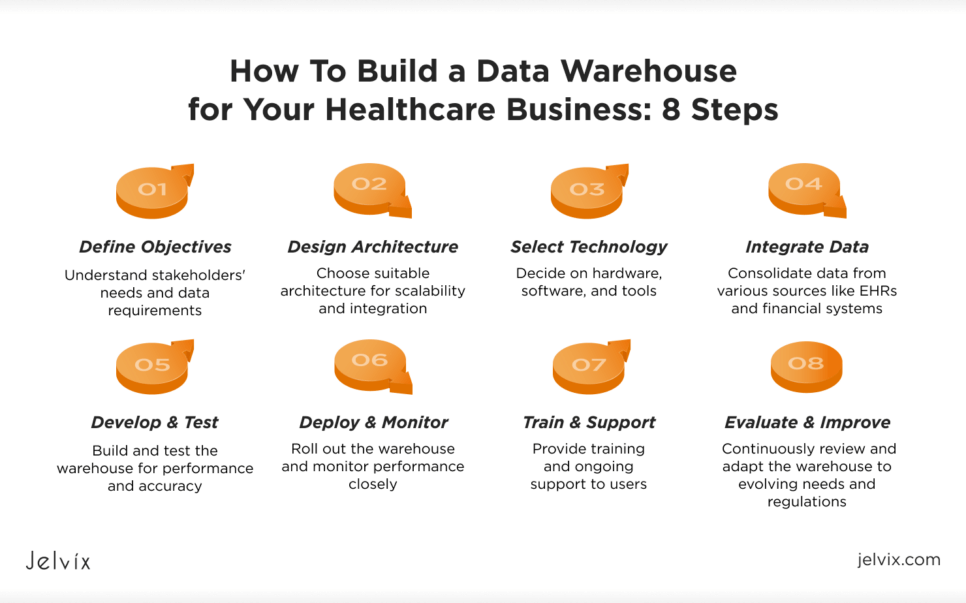Healthcare is responsible for creating about one-third of all the data we generate. By 2025, the amount of data from electronic health records, insurance claims, and billing systems is expected to grow by 36%, which is more than in other sectors.
To handle all this information, many clinics are starting to use data warehouses. But building these isn’t easy without the right legal and technical expertise. Often, issues like keeping the data safe, making sure the system can handle more data as it grows, and keeping its quality high become the primary challenges.
If you want to manage your healthcare data better by using a data warehouse, this article can help. You’ll learn about the common problems with setting up a custom data warehouse and how to solve them. Plus, we’ll look at different ways to build a data warehouse and the important steps needed to make one work well for your clinic.
The Must-Have Features of a Data Warehouse in Healthcare
Even though businesses around the world use modern technology to make their work easier and manage lots of information, healthcare is a bit behind. About 80% of clinics aren’t using all the benefits of digital tools, which means they miss important information from patient data. But thanks to the data management features of an enterprise data warehouse, healthcare entities can tackle this issue.
Data Integration
Healthcare data warehouses can put together information from different sources like medical records, billing info, and patient management systems. By doing this, they make sure all the important data is kept in one spot. This helps doctors see everything they need about a patient in one place, making it easier to make correct health decisions.
Patient-Centric Design
Data warehouses are usually built to focus on patients. They help doctors keep an eye on a patient’s health across different medical settings, which makes it easier to give personalized care.
Security and Compliance
Because patient data is sensitive, it’s important to keep it safe. Data warehouses offer strong security features like controlled access and data encryption to prevent data leaks or unauthorized access. They also follow strict regulations like HIPAA and GDPR to make sure everything is handled correctly.
Advanced Analytics
Medical data warehouses are equipped with powerful tools that can analyze data in complex ways, like predicting health risks or managing large groups of patients. This helps doctors make smart choices and helps managers use clinical resources more efficiently.
Scalability
As more data comes into your clinic, your medical technology needs to be able to handle it smoothly. Data warehouses can grow with your hospital’s needs, which means handling more data without disruptions.
Real-Time Data Processing
Advanced data warehouses offer real-time tracking to handle data right away. This means doctors always have the most up-to-date information and can make informed decisions for patient care quickly.
Interoperability
It’s important that data warehouses can work well with different medical systems and applications. Warehouses usually support the FHIR data model and HL7 standard which makes communication across multiple platforms easier and smoother.
Explore key strategies to enhance healthcare interoperability, from adopting standard data formats to leveraging APIs and ensuring robust security measures.
Customizable Reports and Dashboards
Data warehouses usually have tools that let doctors and healthcare managers look at data in different ways. This helps everyone understand the information better and make decisions that can improve clinical processes and patient care.
Core Benefits of Data Warehousing in Healthcare
Experts predict the market for medical data warehouses will grow by $7.7 billion by 2030. Data warehouses owe this popularity to the numerous benefits they bring to healthcare facilities.
Centralized Data Management
Data warehousing lets clinics bring together data from different sources. This makes it easier to access and manage the data, making sure it’s reliable and useful.
Improved Patient Care
Doctors get a complete picture of a patient’s health from data warehouses, which helps them make better decisions and plan treatments based on real-world evidence.
Enhanced Decision Making
Data warehouses help both doctors and healthcare executives make informed decisions. They can see trends, compare performance, and plan for the future based on the data they have.
Increased Operational Efficiency
Data warehouses automate the pulling and analyzing of data, which cuts down the time and effort needed for physicians. This makes reporting faster and more accurate, freeing up staff to focus on patient care instead of paperwork.
Regulatory Compliance and Reporting
Data warehouses simplify adherence to healthcare regulations by providing tracking, auditing, and reporting tools. They ensure that data management meets legal standards and that reports needed for regulatory compliance are accurate and timely.
Ability To Scale
Data warehouses are built to grow with your clinic’s increasing data needs without a drop in performance. This scalability means that as more data is collected, the system can handle it efficiently without the constant need for upgrading infrastructure.
Key Challenges of Data Warehousing in Healthcare and How To Resolve Them
Implementing and maintaining a data warehouse in healthcare presents several challenges. Addressing them can greatly enhance the value and functionality of your data warehousing system.
Data Integration Complexity
Healthcare data comes from disparate sources and often in different formats which complicates the integration. Implementing robust data integration tools and middleware solutions that can standardize, clean, and transform data into a unified format can be a good idea. Establish a common data model like FHIR across all systems to aid in seamless integration.
High Costs of Implementation and Maintenance
The initial setup and ongoing maintenance of a data warehouse can be costly due to the need for sophisticated hardware and software. Adopting cloud-based data warehousing solutions can reduce upfront capital expenses and operational costs.
Scalability Issues
As healthcare organizations grow, the volume and variety of their data also grow. This can overwhelm existing data warehouses. Designing the warehouse with scalability in mind from the start is essential. This means using scalable cloud services and designing databases that can handle increased loads.
Skill Gaps and Training Needs
The successful deployment and operation of a data warehouse requires specialized knowledge that your staff may not possess. Invest in training and development to help them obtain expertise in data warehousing and healthcare analytics.
Ensuring Data Quality
Poor data quality can make a data warehouse ineffective, leading to inaccurate analyses and decisions. Implement rigorous data governance practices to ensure data accuracy, completeness, and consistency. Also, conduct regular audits and validations to maintain high data quality.
Clinical Data Warehousing: Primary Financial Benefits and Success Factors
Data warehouses in healthcare optimize operational processes and bring significant financial benefits. Understanding the financial advantages and identifying the success factors of healthcare data warehousing can help medical entities optimize their investments in clinical infrastructure.
Financial Benefits of Healthcare Data Warehousing
When a data warehouse becomes an integral part of a whole medical system, it can significantly impact its financial performance because of its ability to cut unnecessary expenses.
Cost Reduction
Warehousing optimizes data management and analysis, resulting in lower costs associated with data storage and retrieval. Data warehouses minimize the need for manual data entry and reduce errors, which decreases the costs related to corrections and adjustments.
Revenue Management
Data warehouses enable effective data management. They do this through better tracking and administration of patient bills and insurance claims. This improved revenue cycle management accelerates cash flow and increases overall revenue efficiency.
Resource Allocation
A data warehouse provides detailed insights into a clinic’s operational efficiency. This helps healthcare administrators make informed decisions about resource allocation and ensure that assets are used most cost-effectively.
Preventive Care Insights
Data warehouses enable the analysis of vast amounts of medical data. This helps identify patterns that predict health issues before they become severe and costly. This preventive care can lead to significant long-term savings by reducing the need for expensive treatments and hospitalizations.
Success Factors for Medical Data Warehouse Implementation
By focusing on key success factors, healthcare entities can maximize the value of their data warehouses, leading to better health outcomes and more efficient operations.
Stakeholder Engagement
Successful data warehousing projects involve stakeholders from the start. Engaging clinicians, IT staff, and administrative personnel helps ensure that the warehouse meets the needs and expectations of all users.
Data Quality and Integrity
Data quality directly affects the reliability of the analytics and reports generated from the data warehouse. Accurate data ensures that staff and executives can trust the insights derived from the data to make informed decisions.
Scalability and Flexibility
Data warehouses must be scalable and flexible to accommodate the future growth of healthcare entities. This includes handling increasing data volumes and integrating new data sources.
Healthcare Data Warehouse Solution Architecture
The architecture of a healthcare data warehouse is a foundation that supports the effective storage, management, and analysis of medical data. This architecture consists of several key components that help clinics improve care outcomes.
Data Sources
Data warehouses aggregate data from a variety of sources including EHRs and patient management systems. These sources provide the raw data that feeds into the warehouse.
Data Integration Layer
Before data can be stored in the warehouse, it must be cleaned, transformed, and standardized. This is done in the data integration layer, following an established ETL process in healthcare (Extract, Transform, Load). This layer ensures that data from various sources is consistent and usable.
Data Storage
The core of a data warehouse is its storage system, which should be scalable and secure. This can be structured using different schemas such as star schema or snowflake schema, which are popular for their efficiency in handling complex queries across large datasets.
Data Management
Effective data management is responsible for maintaining data integrity and accessibility. This includes implementing data governance practices, managing metadata, and ensuring overall data quality. Data management tools and protocols help organize and safeguard the medical info across the system.
Analytical Tools
The warehouse must be equipped with analytical tools that allow for complex data analysis and reporting. These tools support functions, such as querying, reporting, data mining, and predictive analytics, enabling healthcare pros to make informed decisions.
Presentation Layer
The top layer of the architecture is the presentation layer, where data is visualized. It then becomes accessible to end-users through dashboards, reports, and user interfaces. This layer is important for ensuring that insights derived from the data are easily understandable and actionable.
Security Measures
Because of the sensitivity of healthcare data, the warehouse architecture should include robust security measures like encryption, access controls, audit trails, a defense-in-depth strategy, and compliance with healthcare regulations.
Scalability and Flexibility
Data warehouse architecture must be scalable to support the growing amounts of medical data. It should handle the addition of new data sources and integration with other systems, including emerging tech.
Discover how the ETL process impacts healthcare and find insights on handling challenges and implementing best practices for successful ETL processes in healthcare settings.
Approaches to Building a Medical Data Warehouse from Scratch
When building a data warehouse from scratch, you have several strategies to choose from, each with its own advantages.
Top-Down Approach
This approach, also called Inmon’s, involves designing a comprehensive data warehouse that includes detailed data integrated from various source systems. It involves normalizing the data which means organizing it to reduce redundancy and improve integrity. This approach is detailed and helpful in creating a robust data warehouse but can be time-consuming and expensive.
Bottom-Up Approach
Proposed by Kimball, this methodology starts by building data marts for specific groups or departments within the entity. These data marts focus on specific business processes and are designed using a dimensional model, which is generally easier for end-users to understand and handle. This approach allows for quick wins and faster implementation but might lead to challenges in integrating various data marts later.
Hybrid Approach
Combining elements of top-down and bottom-up, the hybrid approach aims to balance the robustness of a normalized data warehouse with the agility of dimensional data marts. This method often involves setting up a centralized data warehouse while developing specific data marts that can be integrated over time.
Agile Data Warehousing
This approach applies agile methodologies to the data warehousing process. It includes iterative development, where the data warehouse changes over time through continuous feedback and revisions. This method is flexible and aligns well with businesses that need to adapt quickly to changing business requirements.
Virtual Data Warehouse
This approach doesn’t involve physical storage but uses technology to make data from various databases accessible as if it were in one place. This approach reduces the complexities and costs associated with data integration and storage but may face challenges in query performance and data consistency.
Each of these approaches has its merits and challenges, and the choice of which to use should depend on your specific needs, resources, and time constraints.
The Smart Way to Choose – Download Your Guide to Selecting the Right Healthcare Tech Partner!

Implementing a Healthcare Data Warehouse: Cost Overview
The cost of implementing a medical data warehouse varies based on the size and complexity of the project, the specific needs of your organization, and the chosen technology:
- Software costs: vary based on whether you choose on-premise software or cloud services, ranging from a few thousand to a hundred thousand dollars;
- Hardware expenses: necessary for on-premise solutions, including servers and storage, potentially costly depending on deployment scale;
- Professional services: fees for design, development, and customization can be significant, often ranging based on employee rates and project complexity;
- Training and support: involves educating staff on system use and ongoing vendor support, with costs varying by support level and training scope;
- Maintenance and upgrades: regular updates and security management are ongoing costs that need consideration for long-term budgeting;
- Data migration: transferring existing data to a new warehouse can be costly, especially with large or diverse data sets;
- Compliance and security: ensuring HIPAA compliance and robust security can add to initial and ongoing expenses.
Note that while upfront and operational costs can be high, the benefits from better decision-making and operational efficiencies often justify the investment in a data warehouse.
How To Build a Data Warehouse for Your Healthcare Business: 8 Steps
Implementing a data warehouse in your healthcare setting involves several considerations that ensure the system is effective, secure, and scalable. By following a step-by-step approach designed by the Jelvix team, you can successfully implement a data warehouse that supports decision-making, improves patient outcomes, and optimizes operational efficiency.
1. Define Business Objectives and Requirements
Clearly define what you want to achieve with your data warehouse. Understand the specific needs of different stakeholders within your clinic, such as clinical staff, administration, and finance teams. This step helps determine the type of data you will collect and how it will be used.
2. Design the Data Warehouse Architecture
Choose an architecture that best suits your needs, whether it’s a traditional monolithic data warehouse, a data lake, or a hybrid approach. Consider data volume, frequency of access, and the complexity of integration. Common architectures include the Kimball and Inmon models the Jelvix team described earlier.
3. Select the Right Technology
Decide on the hardware and software that will form the foundation of your data warehouse. This includes database management systems, ETL tools, and analytics software. Factors like scalability, cost, support, and vendor reputation should influence your choices.
4. Data Integration and Consolidation
Develop a plan for integrating data from various sources, such as EHRs, patient management systems, and financial software. This step involves setting up ETL processes to extract, transform, and load data into your warehouse.
5. Develop and Test
Build the data warehouse according to the specifications and test it for performance, security, and accuracy. Conduct user acceptance testing to ensure that the data warehouse meets the needs of users.
6. Deploy and Monitor
Roll out the data warehouse within your organization. Monitor its performance and usability closely in the initial stages to quickly identify and resolve any issues.
7. Train and Support
Provide training for all end-users on how to effectively use the data warehouse tools. Ongoing support will help them gain the maximum benefit from this investment.
8. Continuously Evaluate and Improve
Regularly review the performance and relevance of your data warehouse. Technology and business need to develop, so your data warehouse should adapt to changes in healthcare regulations, clinical practices, and technology advancements.
How Jelvix Helps Develop a Corporate Data Warehouse in Healthcare
Building a data warehouse on your own is a difficult task. You have vast expertise in technical and compliance aspects to develop a truly effort-worthy solution.
At Jelvix, we offer comprehensive services for developing and implementing data warehouses in healthcare. Our experts provide consultations to identify your data challenges and goals, offering advice on data integration, security, and compliance. We help select the best architecture and tech stack according to your requirements and business goals.
Reach out to our professionals for guidance, and they’ll help you build a tailored data warehousing solution that improves patient care and optimizes operations.
Looking to achieve your business goals with a skilled team of developers?
Let our dedicated professionals help you reach new heights.



